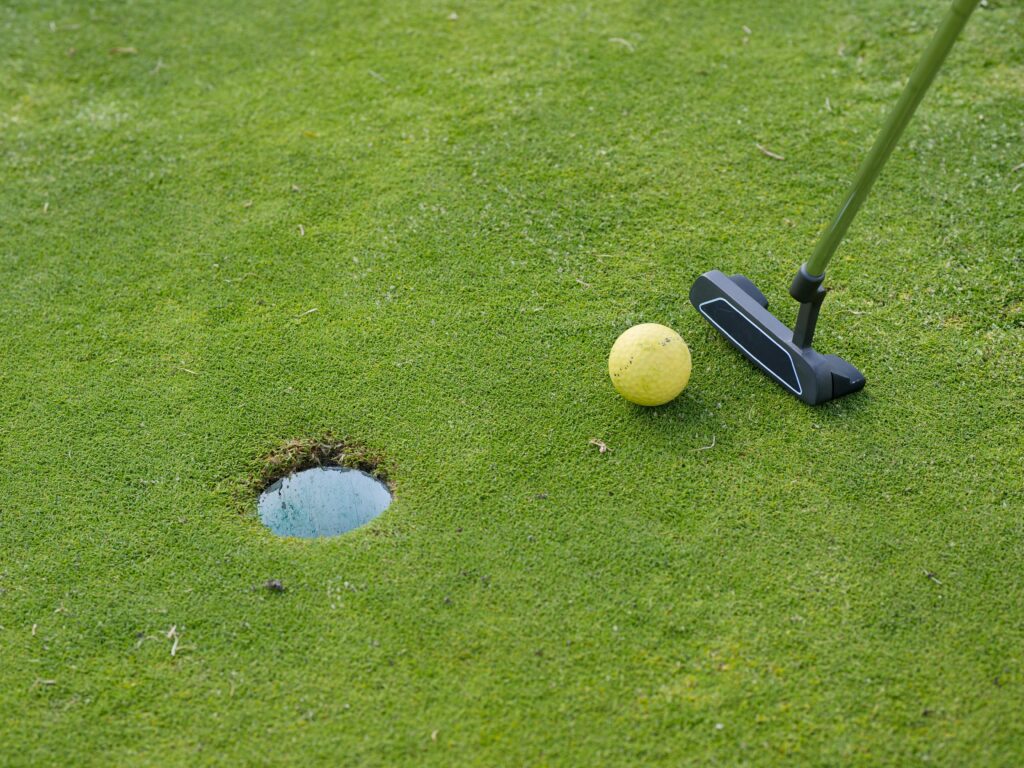10 Best Putting Tips From The Pros To Transform Your Short Game
Posted by
If you’re looking for the best putting tips, we’re here to help. Because let’s face it, there’s nothing worse than hitting it great off the tee and with your approaches, only to struggle on the greens.

What’s funny about putting is that there is no “one way” to putt like the full swing. While some putters – like Tiger Woods – are extremely traditional, other great players use a very different approach.
For example, some players use long putters, others use short putters. Some use a claw grip, others take no practice swings, and some have questionable posture. But if the ball finds the hole, that’s all that matters.
Ultimately, putting is all about using the right grip, putter, and stroke that gives you confidence. Test out different approaches and use these tips to start putting out of your mind.
10 Best Putting Tips
Keep reading to find out the 10 best putting tips to improve your short game and shoot lower scores.
1. Minimize Head Movement
If you want to putt like a pro, like Tiger Woods, Rory McIlroy, or Luke Donald, focus on your head movement (or lack thereof) above all else.
Professional golfers stay very steady and let their arms/shoulders do the work. While everyday amateur golfers sway, move their head on the backstroke, and look up too early which negatively impacts the putt.
Less is more when it comes to head movement, especially on short putts.
Think about keeping your head down on short putts to “hear” them drop vs. see them go in the hole. This is a great practice routine that will train your head to remain stationary.
2. Alignment is Everything
You can have the best putting stroke in the world but if you have poor alignment, you still won’t make a lot of putts. This is why the best golfers in the world consistently use the best putting alignment aids like putting mirrors and other training aids to ensure they’re aligned properly for every stroke.
As Cam Smith (one of the best putters in pro golf) said in Golf Digest, “I definitely keep on top of it…. For me, it ‘s just about getting back to the same setup position, basically. I practice with a mirror for probably 20 minutes a day, and to be honest, that’s about it.”
A putting mirror is one of the best investments you can make in your game. They’re small, portable, and easy to use. Plus, some putting mirrors are big enough to show your shoulder alignment which is also key to setting up properly.
3. Putter Face Control
Once your alignment is dialed in, the next putting tip to remember is to focus on the putter face at impact. If you’re missing putts right or left(and it’s not an alignment issue), it might be because the face is closed at impact. Here’s the Jack Nicklaus putting storke technique to remedy this.
To better understand your putter face first make sure it’s square at address position to your intended start line. As Golf.com said, “ Making sure your putter face is square to the target at impact. Doing so is the single-most important element of your stroke, and the primary arbiter of whether the ball will or won’t start on your intended line.”
Record your putting stroke with a tripod or the help of a golf buddy to check the face position. If you’re setting up properly, then it’s time to review your stroke.
Diagnosing the issue might not be easy and why we suggest finding a Skillest coach to help you out. Sometimes all it takes is a quick lesson to figure out how to get the putter face square.
4. Develop a Green Reading Technique
To make more putts from any range you need a solid green reading technique. The goal is to find the apex for every putt.
As Greg Norman said, “When one does concentrate on the hole on a breaking putt, there can be a tendency to direct your swing that way as well, resulting in pulls on right-to-left putts and pushes on left-to-rights. When you concentrate on the apex spot, you ‘re immune to this.”
Like the putting stroke and grip, there is no “one way” to read greens. Some players use green reading books, others use their feet and Aimpoint, while others read the putts from behind the hole (and from other angles).
Test out different green reading styles in practice to see what yields the best results in your game. Then stick with that method on the course so you’re committed to the break of every putt.
5. Trick Your Mind with Visualization
To putt more consistently and perform under pressure, you need to tap into the power of visualization. As Jack Nicklaus said, “I never hit a shot, not even in practice without having a very sharp, in-focus picture of it in my head.”
While most of us think about visualization for full shots, it’s just as important with putting. You need to give your mind a clear image of where you want the ball to go in the hole.
As Golf Digest said, “The idea behind it [visualization] is simple. All it means is that the same areas of the brain are activated when imagining a movement as actually making that movement.
Meaning, if you were to imagine making a golf swing, many of the same areas within your brain are activated as when actually making the golf swing. In essence, the brain acts the same way when imagining a movement as when actually making the movement.”
During your green reading and pre-shot routine make sure to provide your mind positive images of the ball going in the hole. This will set you up to make a better stroke and minimize costly 3-putts.
6. Work on Your Mindset
Putting is largely mental as the mechanics are much simpler than a full swing. But a lot of golfers sabotage their putting with a poor mental game.
This usually happens from:
- Negative self talk when a putt is missed.
- Poor body language when they don’t convert a mid-range birdie putt.
And general frustration if putts aren’t dropping that day. But I find that a lot of this frustration happens from unrealistic expectations.
For example, did you know that the PGA Tour average make rate from 8-feet is only about 50%? That’s right, the best golfers on the planet only make about half the putts from 8-feet.
Having a better understanding of what you “should” make can help your mental game on the greens.
Best Putting Tips: Understanding Short, Mid, and Long Putts
| DISTANCE | CATEGORY | DEFINITION |
|---|---|---|
| 6 Feet or Less | Short Putt | Short putts are the closest to the hole. They require the golfer to focus primarily on alignment and accuracy to sink the ball into the hole. |
| 6 Feet to 20 Feet | Mid-Length Putt | Mid-length putts pertain to those attempts that go beyond the short putt distance but fall under the 20-feet mark. These putts demand a balance between line accuracy and stroke length to deliver the ball close to or into the hole. |
| 20 Feet or More | Long Putt | Long putts are those that exceed the 20-feet mark from the hole. In this category, golfers put more focus on the correct stroke length to attain the appropriate distance control. The goal is typically to set up for a straightforward second putt. |
7. Make More Short Putts
Short putts are the lowest hanging fruit in golf when it comes to lowering your score.
If you want to drop strokes fast, stop wasting shots from 4 to 8 feet. Especially those 3–4 footers that you’ll need to make for par saves and keep momentum in the round.
Getting the right start line is the most important thing to consider with short putts. This is why it’s very important to have a green reading routine so you can easily identify the break.
If you’re missing short putts often make sure to notice if it’s a consistent miss right, left, or short of the hole. If you’re missing right or left, it might be a setup issue that can easily be fixed with a putting mirror. And if you’re missing short, try to accelerate more so you get the ball to the hole.
8. Master Mid-Length Putts
As mentioned in point #6, most pros don’t make a lot from mid-range. According to the PGA Tour in the 2021-2022 season the average make rate from 15 to 25 feet was only 15.87%.
Don’t forget these are elite golfers on perfect greens, with the best coaches and equipment. Yet, they only make a little more than 15% of putts from mid-range. So don’t be surprised if you miss more than you make from mid-range distance.
For mid-length putts focus on speed and a proper start line. Recording your stroke with a down the line angle is a great way to evaluate your mid-range putting in practice.
9. Learn to Lag Long Putts
With longer putts the number one focus is distance control. While the break is important too, having the right speed is the key to avoiding 3-putts from long range.
Here’s why…
Last season on the PGA Tour the average proximity to the hole was 36 feet from the fairway and 45 feet from the rough. Yet most everyday golfers rarely practice from this range and wonder why they waste so many shots on the greens.
The best way to improve your lag putting is spending your practice time on 30–40 footers. This will improve your feel and distance control to avoid three putts.
10. Don’t Avoid Putting Practice
Whenever I go to the golf course to practice I see 90% of players on the driving range and 10% at the short game area. But if you want to get better fast it’s essential to spend more time on the putting green.
Spend a majority of your time on short putts as they’re the easiest putts to make on the course. As Dr. Bob Rotella said, “ Practicing from close range assures them of making most putts they try. There’s nothing better for your confidence and your putting than seeing balls go in the hole time after time.”
When you apply these putting tips and create a consistent putting schedule, you should notice a huge improvement in your short game.
